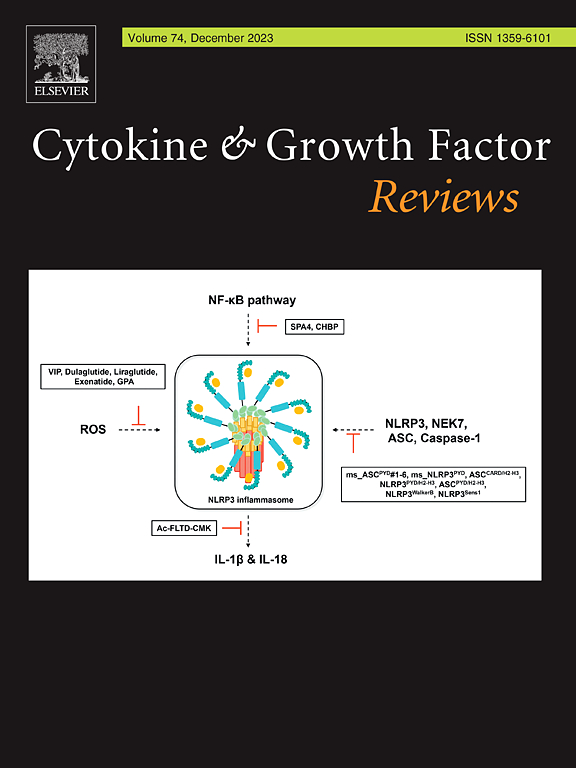mTOR通路与慢性阻塞性肺疾病(COPD)发病机制的耦合
IF 9.3
2区 医学
Q1 BIOCHEMISTRY & MOLECULAR BIOLOGY
引用次数: 0
摘要
慢性阻塞性肺疾病(COPD)是一种可逆性较差的呼吸系统疾病,以呼吸困难、咳嗽、咳痰和因气道异常或肺气肿而加重为特征。在这篇综述中,我们考虑靶向雷帕霉素(mTOR)的哺乳动物靶点治疗COPD的治疗潜力。mTOR是一种高度保守的丝氨酸-苏氨酸蛋白激酶,整合来自生长因子和营养物质的信号,控制蛋白质合成、脂质生物发生和代谢。由于遗传因素或吸烟导致的mTOR通路信号失调会损害自噬,导致异常细胞和受损蛋白质的积聚,导致炎症和氧化应激。持续的mTOR激活也有助于肺血管细胞增殖,促进COPD肺阻力的发展。雷帕霉素是mTOR的一种抑制剂,可以防止慢性阻塞性肺病患者肺部衰老细胞的积累,并抑制肺组织损伤蛋白酶的释放。mTOR还通过调节组蛋白去乙酰化酶水平影响COPD患者的皮质类固醇敏感性。肠-肺轴失调在COPD进展中的新作用及其对mTOR的影响进一步强调了mTOR通路在COPD病理生理中的相关性。本文章由计算机程序翻译,如有差异,请以英文原文为准。
Mechanisms coupling the mTOR pathway to chronic obstructive pulmonary disease (COPD) pathogenesis
Chronic Obstructive Pulmonary Disease (COPD) is a poorly reversible respiratory disorder distinguished by dyspnea, cough, expectoration and exacerbations due to abnormality of airways or emphysema. In this review, we consider the therapeutic potential of targeting Mammalian target of Rapamycin (mTOR) for treating COPD. The mTOR is a highly conserved serine-threonine protein kinase that integrates signals from growth factors and nutrients to control protein synthesis, lipid biogenesis and metabolism. Dysregulated mTOR pathway signaling due to genetic factors or cigarette smoking impairs autophagy, driving the buildup of abnormal cells and damaged proteins, resulting in inflammation and oxidative stress. Persistent mTOR activation also contributes to pulmonary vascular cell proliferation, facilitating the development of pulmonary resistance in COPD. Rapamycin, an inhibitor of mTOR, prevents the buildup of senescent cells in the lungs of COPD patients and inhibits the release of lung tissue-damaging proteases. mTOR also impacts the corticosteroid sensitivity in COPD patients by regulating the levels of histone deacetylases. The emerging role of gut-lung axis dysbiosis in the progression of COPD and its influence on mTOR further highlights the relevance of the mTOR pathway in COPD pathophysiology.
求助全文
通过发布文献求助,成功后即可免费获取论文全文。
去求助
来源期刊

Cytokine & Growth Factor Reviews
生物-生化与分子生物学
CiteScore
21.10
自引率
1.50%
发文量
61
审稿时长
22 days
期刊介绍:
Cytokine & Growth Factor Reviews is a leading publication that focuses on the dynamic fields of growth factor and cytokine research. Our journal offers a platform for authors to disseminate thought-provoking articles such as critical reviews, state-of-the-art reviews, letters to the editor, and meeting reviews.
We aim to cover important breakthroughs in these rapidly evolving areas, providing valuable insights into the multidisciplinary significance of cytokines and growth factors. Our journal spans various domains including signal transduction, cell growth and differentiation, embryonic development, immunology, tumorigenesis, and clinical medicine.
By publishing cutting-edge research and analysis, we aim to influence the way researchers and experts perceive and understand growth factors and cytokines. We encourage novel expressions of ideas and innovative approaches to organizing content, fostering a stimulating environment for knowledge exchange and scientific advancement.
 求助内容:
求助内容: 应助结果提醒方式:
应助结果提醒方式:


